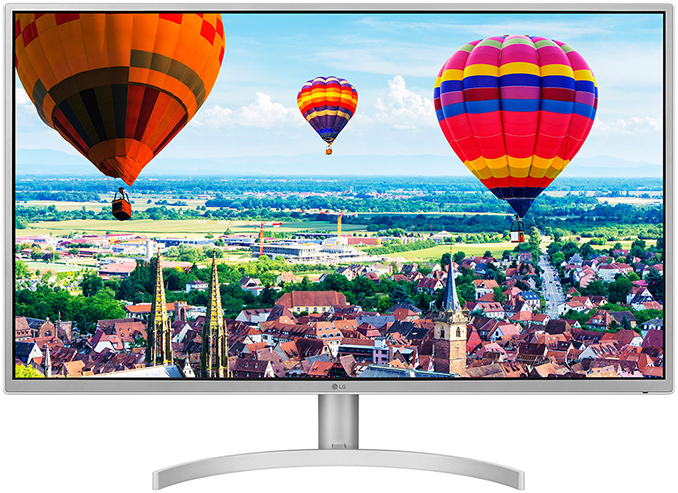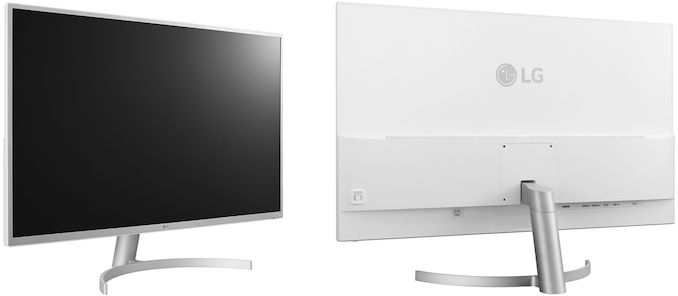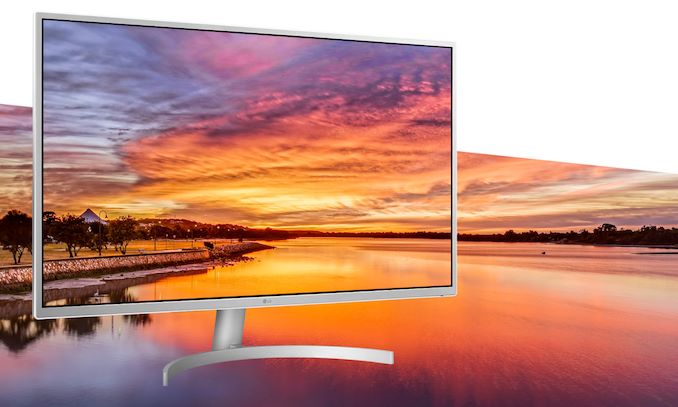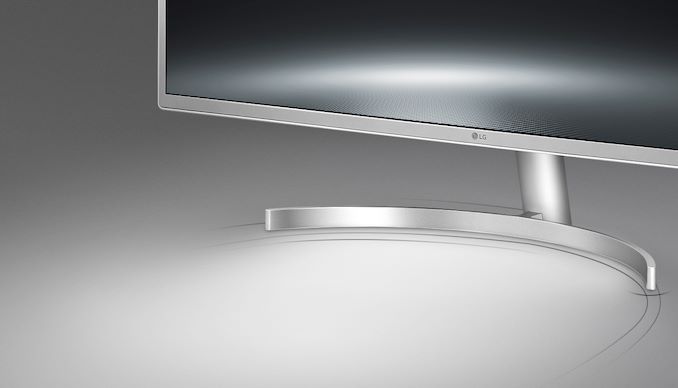LG Launches 32QK500-W QHD Display: IPS and Freesync for $300
by Anton Shilov on December 14, 2018 10:00 AM EST
LG has introduced its new entry-level display designed for the mainstream market but supports a number of premium features such as AMD’s FreeSync dynamic refresh rate tech. The 32QK500-W relies on an IPS panel and features a larger size and a higher resolution than most monitors in the ~$300 class.
High-end displays for enthusiasts and gamers evolve at a rather rapid pace with improved and larger models introduced every year. On the other hand, workhorses used for everyday work and play are updated on a much longer cadence. In fact, the most popular LCD models on the market still feature 23.5-inch to 27-inch 8-bit Full-HD panels and do not support any modern technologies. While not being a high-tech breakthrough, LG’s 32QK500-W changes what we come to expect from a budget monitor produced by a renowned brand.
The 32QK500-W relies on an 8-bit + FRC 31.5-inch IPS panel with a 2560×1440 resolution, 300 nits brightness, 1000:1 contrast ratio, 75 Hz refresh rate (with FreeSync), an 8 ms response time, and 178°/178° viewing angles. The monitor can display 1.07 billion colors (a rare feature in this class) and is rated at 72% NTSC CIE1931 (roughly equals to 100% sRGB).
Being aimed at SOHO market, the LG 32QK500-W does not omit gaming features. In addition to already mentioned AMD FreeSync (works only over HDMI), the monitor also supports LG’s Dynamic Action Sync that skips some of the internal image processing to cut down input lag when activated. There is also the Black Stabilizer motion blur reduction tech that makes fast-paced scenes look sharper by inserting a black image between frames (though it remains to be seen how well it is going to work with a 75 Hz panel), and the Crosshair overlay to simplify lives of FPS gamers.
As far as connectivity is concerned, the LG 32QK500-W has one DisplayPort, one Mini DisplayPort, and two HDMI inputs. In addition, the display has a 3.5-mm audio connector for headphones.
Like premium monitors from LG, the 32QK500-W features the company’s stylish Edge-ArcLine stand that in the case of the particular display enables to adjust tilt. Alternatively, the stand can be detached and the LCD mounted to the wall using VESA 100x100 mm mounting holes.
| Specifications of the LG 32QK500-W 31.5-Inch Display | ||
| 32QK500-W | ||
| Panel | 31.5" IPS | |
| Native Resolution | 2560 × 1440 | |
| Maximum Refresh Rate | 75 Hz | |
| Dynamic Refresh Rate | AMD FreeSync | |
| Response Time (Grey-to-Grey) | 8 ms | |
| Brightness | 300 cd/m² | |
| Contrast | 1000:1 | |
| Viewing Angles | 178°/178° horizontal/vertical | |
| Pixel Pitch | 0.2727 × 0.2727 mm | |
| Pixel Density | 93 PPI | |
| Color Gamut | 99% sRGB (tbc) 72% NTSC CIE1931 |
|
| Inputs | 1 × DisplayPort 1 × Mini DisplayPort 2 × HDMI |
|
| Audio | 3.5-mm headphone jack | |
| Stand | Can adjust tilt | |
| Power Consumption | Standby | 0.5 W |
| Typical | 46 W | |
| Maximum | 50 W | |
The LG 32QK500-W is currently listed at many of the company’s websites around the world. Considering the fact that the product does not feature any unproven technologies, it is likely that the display will hit the market shortly. The price of the new unit in Japan is estimated to be ¥34,800 ($307) without tax, so it is safe to say that the monitor will retail for $299 in the US.
Related Reading
- LG Unveils 32UK550: 31.5 Inch 4K Display with DCI-P3, HDR10, & FreeSync for $500
- Dell Announces Ultrathin S2719DC LCD: FreeSync USB-C with HDR600
- LG Develops ‘Nano IPS’ LCD, Unveils 32UK950 4K Display with DCI-P3, HDR600, TB3
- Smooth As 240 Hz Butter: LG's 27GK750F-B, a 27-inch eSports Monitor with FreeSync, Launched for $550













28 Comments
View All Comments
Alistair - Friday, December 14, 2018 - link
I really wish all these freesync monitors would adopt 90hz as the new standard now that pixel response times have improved. Fast enough for high speed gaming, and compatible with 30hz content (75hz vsync is bad for youtube). I don't really need 165hz honestly, but 90 is a big step up from 60. I don't understand why it would cost anything extra at all to allow 90hz options... It took so long to go from 60 to 75, let's make 90hz a new standard. Is LG listening? They could be a brand that promises 90hz across every product <4k, it would make for unique branding.haukionkannel - Friday, December 14, 2018 - link
I agree! 90Hz is good point for refresh. The monitor does not feel much faster after that and the 30HZ in the low end is possible with high end GPUs even in tricky situations.Of Course 32" start to be size where 4K becomes more viable, but this is low end model, so the resolution is just fine for that. 36" would be even better, so you don't need very high scaling factor to make text big enough for 4K. 32" 1440p does not need scaling at all. I use 150% scaling in 27" 1440p resolution monitor, I would prefer somewhat smaller scaling so this may be good for that.
Midwayman - Friday, December 14, 2018 - link
75hz for IPS and freesync isn't that bad. Games do feel a lot more fluid with variable sync. If they went with a MVA or TN panel they could get to 90hz a lot easier. Since these are variable sync monitors I sort of wonder if it can't just be handled in software. Get a plugin that detects 30hz content and it'll drop the desktop to 60hz so you don't have to do weird pulldown.Alistair - Friday, December 14, 2018 - link
75hz isn't bad from a speed perspective, but a compatibility one. Even when I play 60hz games for example there are a lot of 30fps cutscenes that don't work out properly at 75hz. 90hz would solve all my issues.xTRICKYxx - Tuesday, December 25, 2018 - link
Why not 180hz or 240hz? :)zamroni - Sunday, December 16, 2018 - link
It's ips limitation. You get better picture with ips but limited refresh rate. The 120 mhz gaming monitor uses tn panel.Alistair - Tuesday, December 18, 2018 - link
You can use overdrive (OD) to run any modern panel fast enough to hit 90hz.xTRICKYxx - Tuesday, December 25, 2018 - link
I have gotten to play with a few 75hz panels with 0 overclockability. Most 60hz panels I can eek out another 10hz or so.yasamoka - Thursday, December 20, 2018 - link
There are IPS displays that are 1440p 165Hz, 3440x1440 120Hz, 4K 144Hz.Every display worth anything these days uses overdrive to hit respectable response times, even at a refresh rate of 60Hz, and IPS is no exception. Lower response times improve motion clarity and reduce smearing even if higher response times would still permit a frame to be drawn properly before the next refresh - letting response times float up means your image is almost never in its final form before the next refresh.
euskalzabe - Friday, December 14, 2018 - link
You have to love how they release these upgrades right after clearing their inventory on Black Friday. Here's hoping this kind of billion-color panel will expand to 29" ultrawide monitors, even if they're only 1080p.